Have you ever intended to build strength in your upper body but do not have access to a gym or any complicated equipment? Then, you could try dumbbell push-ups.
Unlike standard push-ups, which can become too easy over time, adding dumbbells increases the intensity.
They are also useful for breaking through strength plateaus when standard push-ups no longer provide enough challenge.
This comprehensive guide will teach you proper form and techniques. Learn how to progress into advanced push-up variations to build muscular endurance safely.
Please read our guide for all the details about this simple yet effective exercise.

- What is Dumbbell Push-Ups
- Muscle Worked During Dumbbell Push-Ups
- How To Properly Perform Dumbbell Push-Ups
- Common mistakes that should be avoided
- 1. Arching the back
- 2. Not keeping the core engaged
- 3. Lifting the hips too high or allowing them to sag
- 4. Lower Head, Not Chest
- 5. Allowing the elbows to flare out to the sides
- 6. Not keeping the neck in a neutral position
- 7. Using too much momentum
- Variations of Dumbbell Push-Ups
- 1. Dumbbell T Push up
- 2. Wide Grip Dumbbell Push Ups
- 3. Close Grip Dumbbell Push Ups
- 4. Renegade Row Push Ups
- 5. Single Dumbbell Push Ups
- 6. One-Arm Dumbbell Push-Ups (Uneven Push-ups)
- 7. Feet-elevated Dumbbell Push Ups
- 8. Dumbbell Diamond Push-Ups
- Benefits of Dumbbell Push-Ups
- 1. Increased muscle activation
- 2. Improved stability and balance
- 3. Greater range of motion
- 4. Improved strength and endurance
- 5. Improve Your Posture and Flexibility
- 6. Increased versatility
- Incorporating Dumbbell Push-ups Into A Workout Routine
- FAQs
- Dumbbell push ups vs. Regular Push Up
- Are dumbbell push-ups harder?
- Is it good to do push-ups on dumbbells?
- Takeaways
What is Dumbbell Push-Ups
Dumbbell push-ups are a variation of the traditional push-up exercise.
They involve using a pair of dumbbells instead of the hands to perform the push-up movement.
Dumbbell push-ups target the same muscle groups as regular push-ups, including the chest, triceps, and shoulders.
The effort needed to stabilize the weights also engages auxiliary muscles like the forearms and abdominals.
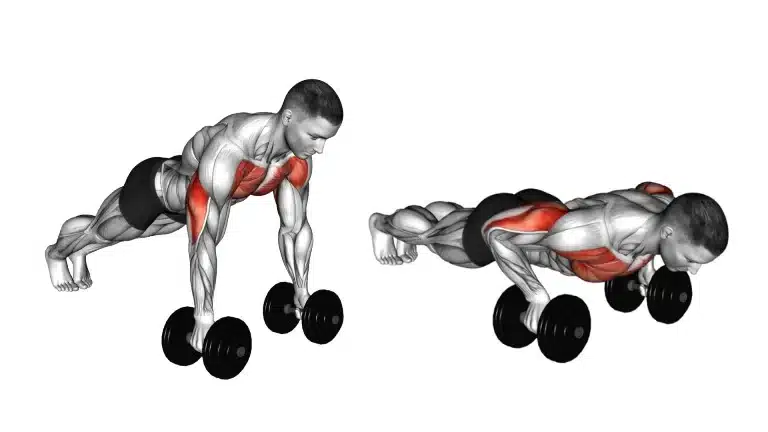
Muscle Worked During Dumbbell Push-Ups
Dumbbell push-ups primarily work the chest muscles (pectoralis major and minor), as well as the triceps and the front of the shoulders (anterior deltoids).
They also engage the core muscles, back muscles, serratus anterior as they help to stabilize the body during the exercise.
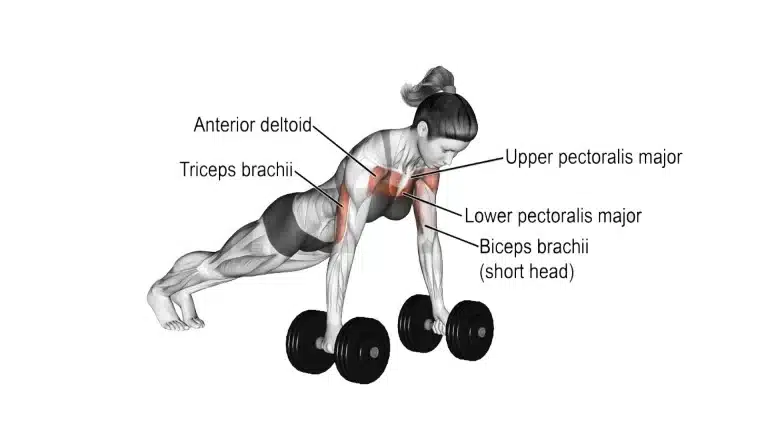
Here’s how these muscles are engaged during the dumbbell push-up:
- Chest muscles: The chest muscles are responsible for moving the arms and shoulders, and they’re activated as you push your body away from the wall.
- Triceps: The triceps are the muscles on the back of the upper arm, and they’re responsible for extending the elbow. They’re engaged as you straighten your arms during the push-up.
- Shoulders: They are responsible for flexing the arm and engaged as you lift your body off the wall.
It is a great exercise for strengthening the upper body, including the chest, triceps, shoulders, and core muscles.
How To Properly Perform Dumbbell Push-Ups
Using a dumbbell for push-ups makes push-ups a more powerful exercise and helps you increase upper body strength, muscle mass, and overall balance.
To perform dumbbell push-ups, follow these steps:
- Grip a dumbbell in each hand and get into a plank position with your palms facing down towards the floor.
- Now, raise yourself off the ground, straightening your elbows and your arms, but keep your elbows close to your body.
- Raise until your elbows are locked, and pause momentarily at the movement’s top.
- Now lower your body under slow, sustained motion, feeling the motion all the way down until your chest is very close to the ground.
- Repeat the movement for the desired number of repetitions.
Common mistakes that should be avoided
Here are a few common mistakes to avoid when performing dumbbell push-ups:
1. Arching the back
It’s important to keep the body straight from head to heels during the exercise.
Arching the back can strain the lower back and may cause injury.
2. Not keeping the core engaged
Engaging the core helps to maintain proper body alignment and stability during the exercise.
Failing to engage the core can result in poor form and may increase the risk of injury.
3. Lifting the hips too high or allowing them to sag
Lifting your hips too high or allowing them to sag can strain your lower back and can cause improper muscle activation.
The body should remain straight from head to heels during the exercise.
4. Lower Head, Not Chest
Many people drop their heads toward their hands when they perform a push-up.
This puts pressure on the front of your shoulders, increasing the risk of shoulder pain and injury.
Instead, you should shift forward a little as you come down so that your chest comes toward your hands.
5. Allowing the elbows to flare out to the sides
The elbows should stay close to the body during the exercise to effectively target the chest and triceps.
Allowing the elbows to flare out to the side can cause strain on the shoulders and may lead to improper muscle activation.
6. Not keeping the neck in a neutral position
It’s important to keep the neck in a neutral position (in line with the spine) during the exercise to avoid strain on the neck muscles.
Tilting the head too far forward or back can disrupt proper body alignment and may cause neck strain.
7. Using too much momentum
It’s important to perform the exercise with control and minimal momentum to effectively engage the correct muscle groups.
Using too much momentum can reduce the effectiveness of the exercise and may increase the risk of injury.
Variations of Dumbbell Push-Ups
Try adding different grip variations, widening or narrowing your grip, and playing with the placement of your feet.
Incorporating various exercises into your routine will increase the workout’s effectiveness and help keep things interesting.
Here are a few of the best variations of dumbbell push-ups that can add variety to your workout routine:
1. Dumbbell T Push up
Dumbbell T push-ups, or DB T-stand push-ups, involve lifting one hand off the ground and reaching it towards the ceiling to form a T shape with the body.
This exercise targets the chest, triceps, shoulders, and core muscles, which are engaged to maintain proper body alignment and stability during the exercise.

How To Do Dumbbell T Push Ups
- Grip a dumbbell in each hand.
- Walk your feet back until your body is straight from head to heels.
- Your arms should be fully extended, with your hands on the dumbbells directly under your shoulders.
- Engage your core and keep your body straight as you lower your chest down towards the dumbbells.
- Keep your elbows close to your body as you lower.
- Once your chest touches the dumbbells, press back up to the starting position and lift one hand off the dumbbell.
- Reach the hand towards the ceiling, forming a T shape with your body.
- Lower the hand back down to the dumbbell and repeat the movement on the other side.
- Continue alternating sides for the desired number of times.
2. Wide Grip Dumbbell Push Ups
Dumbbell wide grip push ups are a variation of dumbbell push ups that involve placing the hands wider than shoulder-width apart on the dumbbells.
This variation targets the outer chest muscles (pectoralis major) more heavily and can help increase the exercise’s difficulty.
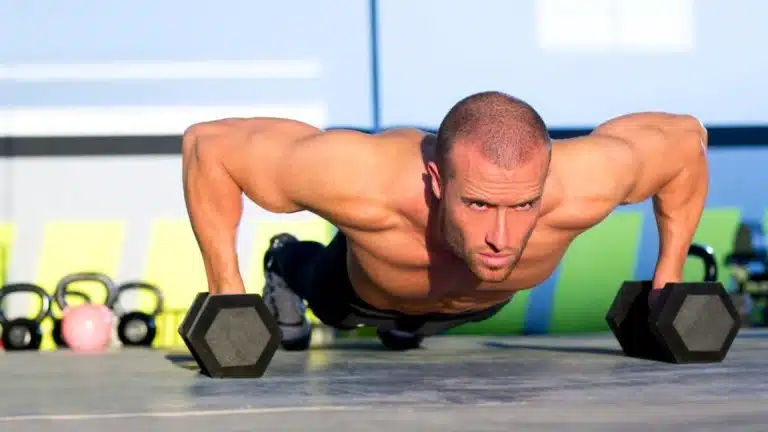
How To Do Wide Grip Dumbbell Push Ups
- Place a pair of dumbbells on the ground in front of you.
- Stand facing the dumbbells and place your hands on the ends of the dumbbells.
- Walk your feet back until your body is straight from head to heels.
- Engage your core and keep your body straight as you lower your chest down towards the dumbbells.
- Once your chest touches the dumbbells, press back up to the starting position.
Know More: 20 Different Types Of Push Ups For Mass And Strength
3. Close Grip Dumbbell Push Ups
Close grip dumbbell push-ups are a variation of dumbbell push-ups that involve placing the hands closer together on the dumbbells.
This variation emphasizes the triceps more and can help to improve arm definition.
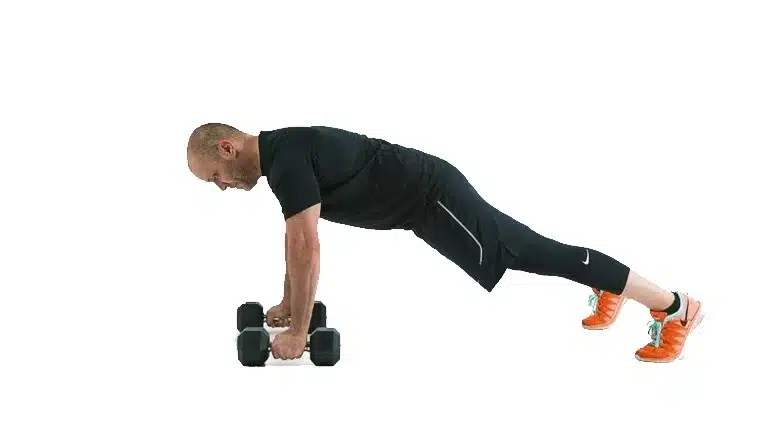
How To Do Close Grip Dumbbell Push Ups
- Grip a dumbbell in each hand, positioning them closer together than shoulder-width apart.
- Walk your feet back until your body is straight from head to heels.
- Your arms should be fully extended, with your hands on the dumbbells directly under your shoulders.
- Keep your elbows close to your body as you lower down.
- Once your chest touches the dumbbells, press back up to the starting position, fully extending your arms.
4. Renegade Row Push Ups
Renegade row push-ups are a compound exercise that combines a push-up with a dumbbell row.
This exercise targets the chest, triceps, shoulders, back muscles, and core.
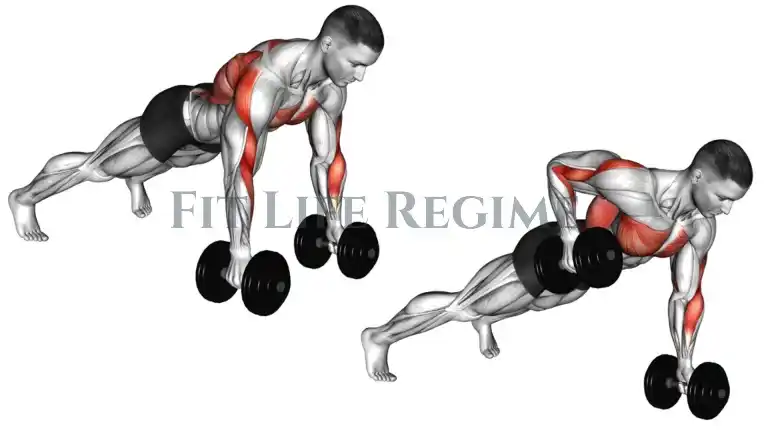
How To Do Renegade Row Push Ups
- Grip a dumbbell in each hand, positioning them slightly wider than shoulder-width apart.
- Engage your core and keep your body straight as you lower your chest down towards the dumbbells.
- Keep your elbows close to your body as you lower down.
- Once your chest touches the dumbbells, press back up to the starting position, fully extending your arms.
- As you press up, row one dumbbell up towards your chest, keeping your elbow close to your body.
- Lower the dumbbell back down to the ground and repeat the movement on the other side.
- Continue alternating sides for the desired number of repetitions.
5. Single Dumbbell Push Ups
Single dumbbell push-up variations also improve grip strength, which is essential when handling heavy dumbbells.
This is a great full-body exercise because the abs, glutes, and thighs will contract in this position to support you.
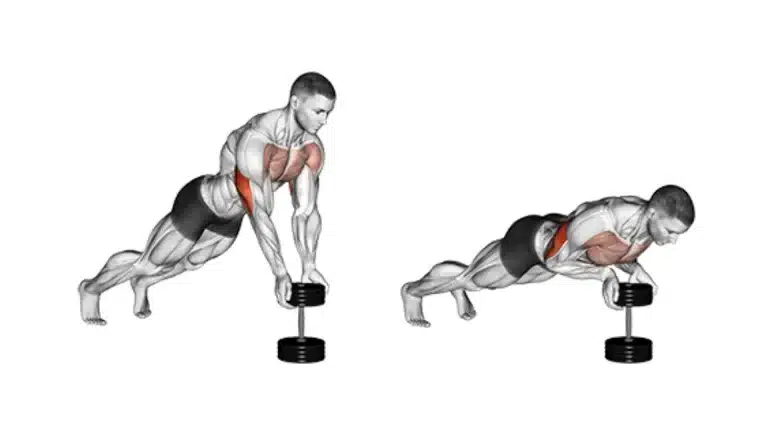
How To Do Single Dumbbell Push Ups
- Place one dumbbell on the floor standing, grabbing the head with your hands.
- Position yourself in a plank position with your arms straight and directly below your chest.
- Lower your body down and push back up.
6. One-Arm Dumbbell Push-Ups (Uneven Push-ups)
Instead of using two dumbbells, use only one.
This variation requires a greater level of stability and balance, as well as increased strength in one arm.
7. Feet-elevated Dumbbell Push Ups
Place your feet on an elevated surface, such as a bench or step, while doing dumbbell push-ups.
This increases the difficulty of the exercise and targets the upper chest muscles more heavily.

8. Dumbbell Diamond Push-Ups
Dumbbell push-ups are more effective than regular diamond push-ups.
It helps your triceps grow faster by targeting them more deeply.
If you want to do it, place the dumbbells on the floor so that they form an A shape.
Remember to start with a variation that is appropriate for your current fitness level and gradually progress to more challenging variations as you become stronger.
Maintaining proper form and technique throughout the exercise is important to avoid injury and ensure that you are targeting the correct muscle groups.
Know More: 15 Bodyweight Triceps Exercises: Beginner to Advanced
Benefits of Dumbbell Push-Ups
Some benefits of dumbbell push-ups include:
1. Increased muscle activation
Using dumbbells in place of the hands can increase muscle activation in the chest, triceps, and shoulders.
2. Improved stability and balance
Because the dumbbells are not as stable as the hands, dumbbell push-ups require more core stability and balance. This can lead to improvements in overall body control and coordination.
3. Greater range of motion
Dumbbells allow for a greater range of motion in the shoulder joint, which can help increase flexibility and mobility.
4. Improved strength and endurance
Dumbbell push-ups can help improve upper body strength and endurance like regular push-ups.
Furthermore, regular DB push-ups will also improve your coordination and balance, which are essential for everyday movements.
5. Improve Your Posture and Flexibility
It helps strengthen and tone your core muscles while improving your posture.
Regularly doing dumbbell push-ups can improve posture by strengthening the chest, shoulder, and back muscles, ultimately increasing flexibility in these areas.
6. Increased versatility
Dumbbell push-ups can be easily modified to fit any fitness level, making them a versatile exercise that can be incorporated into any workout routine.
Incorporating Dumbbell Push-ups Into A Workout Routine
There are a few ways to incorporate dumbbell push-ups into a workout routine:
- As a substitute for regular push ups: Dumbbell push ups can be used as an alternative to regular push-ups to mix up your routine and challenge the muscles differently.
- As a way to increase difficulty: If you can perform regular push ups with ease, you can try using dumbbells to increase the difficulty of the exercise. This can help to continue challenging your muscles and promote further strength and endurance gains.
- As a part of a full-body workout: Dumbbell push ups can be incorporated into a full-body workout along with other exercises that target different muscle groups. For example, you could pair dumbbell push-ups with exercises like squats, lunges, or rows to create a well-rounded routine.
FAQs
Dumbbell push ups vs. Regular Push Up
Both dumbbell push ups and regular push-ups are effective exercises that can help to build upper body strength and improve muscular endurance.
However, there are a few key differences between the two exercises:
- Muscle activation: Using dumbbells in place of the hands during dumbbell push ups can increase muscle activation in the chest, triceps, and shoulders. This can make the exercise more challenging and help to promote further strength and endurance gains.
- Range of motion: The use of dumbbells allows for a greater range of motion in the shoulder joint during dumbbell push ups, which can help to increase flexibility and mobility.
- Stability and balance: Because the dumbbells are not as stable as the hands, dumbbell push ups require more core stability and balance. This can lead to improvements in overall body control and coordination.
- Modification: Dumbbell push-ups can be easily modified to fit any fitness level, making them a versatile exercise that can be incorporated into any workout routine.
The choice between the two will depend on your fitness goals and current fitness level.
Are dumbbell push-ups harder?
Push-ups using dumbbells can be more challenging than regular push-ups due to the increased instability of the dumbbells. It requires more stability and balance in the core.
However, the difficulty of dumbbell push-ups will depend on your current fitness level.
If you cannot perform regular push-ups with proper form, it may be more challenging to perform dumbbell push-ups.
Is it good to do push-ups on dumbbells?
Yes, it can be beneficial to do push ups on dumbbells as they can add an element of instability to the exercise, increasing muscle activation and improving overall body control and coordination.
Using dumbbells in place of the hands during push-ups can also increase the range of motion in the shoulder joint. That can help improve flexibility and mobility.
Takeaways
The dumbbell push-up is a great way to build strength in your chest and arms without a gym or complicated equipment.
They can help build upper-body strength and improve overall muscular endurance.
It can be easily modified to fit any fitness level, making it a versatile exercise.
Adding it to your workout routine lets you change up your push-up routine and keep your muscles working hard.

Manish brings over 10 years of hands-on experience in weight lifting and fat loss to fitness coaching. He specializes in gym-based training and has a lot of knowledge about exercise, lifting technique, biomechanics, and more.
Through “Fit Life Regime,” he generously shares the insights he’s gained over a decade in the field. His goal is to equip others with the knowledge to start their own fitness journey.
